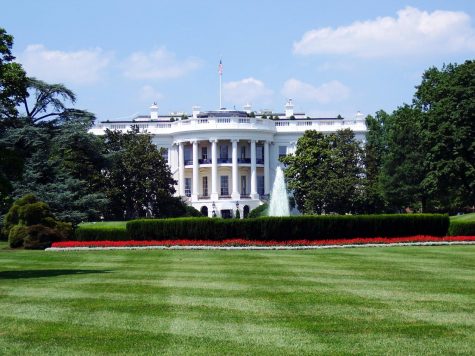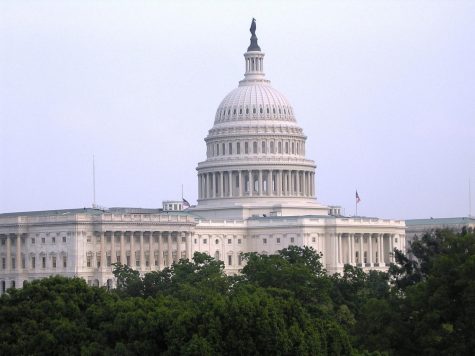Crossfire: Gun Control
Students renew focus on gun reform
Emery Laird
Staff Writer
Since the 1930s, the United States government has tried to regulate the production and sale of firearms in order to increase public safety. President Franklin D. Roosevelt passed the National Firearms Act of 1934, which levied a $200 tax on the transportation machine guns and sawed-off shotguns. The National Firearms Act of 1938 required citizens to have a license for interstate gun dealers, as well as prohibited selling firearms to convicted felons. After this, President Lyndon B. Johnson passed the Gun Control Act of 1968, which fixed constitutional issues, added language about “destructive devices” (such as bombs, mines and grenades), and expanded the legal definition of “machine gun.” The possession of firearms in the home has been been hotly debated. Since the Sandy Hook school shooting in Dec. 2012, the issues of school shootings and whether or not a citizen should be allowed to possess a firearm has been debated in the U.S. The discussion has recently exploded in the U.S. after the Marjory Stoneman Douglas High School shooting on Feb. 14, 2018. Many think that continuing to allow free gun purchase will enable the serial school shooting problem to solve itself. However, if free gun purchase continues, America will continue to see the upward trend of mass shootings.
Numerous first-world countries, such as Japan, China, and Australia, have almost completely eradicated mass shootings. These countries all have either heavy regulations or an outright ban on citizens owning firearms, which mostly stemmed from mass shootings. It is important to note that these countries did something about the gun violence within the country. America is notorious for citizens being reluctant to give up their second amendment rights, which is the primary reason for the US Government being so hesitant on issuing heavier gun regulations. Nevertheless, heavier gun regulations will inevitably decrease the body count in the United States.
A major problem in the U.S. is the school shootings. These shootings started occurring frequently in the 1990’s, after the Columbine shooting. These shootings are often caused by the copycat crime effect, which is defined as a crime that is committed in admiration of a crime committed before. This effect influences mass shootings nationwide, and as a result, causes mass amounts of casualties within the U.S. Most of the perpetrators of these crimes have been found to have some sort of issue with their mental health, and there were often signs, such as social media posts and past crime history, to indicate the person might have had a mental health problem. This means that guns are available to people who have a high risk of harming themselves or others. To counteract this, the US should require mental health evaluations before someone purchases a gun. These evaluations would include psychological testing provided by licensed professionals and a waiting period to conclude that the person poses no threat to themselves or others. Mental health evaluations would help the problem of mentally unstable people acquiring guns to do harm to the public.
In addition to mental health evaluations, the US government needs to make sure that stores do complete and thorough background checks on their customers. Currently only nine states require both licensed and unlicensed gun dealers to do background checks. The other 41 only require federally licensed companies to issue background checks. This would systematically lower the number of criminals that could potentially gain possession of a gun. By doing this, the risk of a mass shooting and gang violence will decrease dramatically, which then lowers fatalities in the US caused by gun-related violence.
Many talk about arming teachers in schools. By giving the teachers guns, an active shooter should be neutralized quickly. However, funding this would cost thousands of dollars. Not only would the government have to buy the guns, but they would also have to do yearly training for teachers. In addition, more students could potentially get hurt in the crossfire. Plus, teachers did not get a degree to play the role of soldiers in schools. Arming teachers would be the equivalent of arming doctors; both professions want to help, not hurt. Therefore, arming teachers in schools is not the solution to gun violence.
Another aspect of gun control is guns in the home. Child deaths occur each year from a firearm accidentally going off in the home. Guns are often not locked up, kept loaded, and are within a child’s reach in the home. Repercussions of this include teenage suicides and accidental deaths while a child is playing with that gun. By requiring owners to lock up their guns in a safe, teenage and child deaths will dramatically decrease the number of deaths in the average American home.
While guns can be useful when used safely, some of the time gun usage is dangerous. By not placing stronger restrictions on buying and selling guns, the government is placing the American people in danger.
U.S. citizens stray from the importance of gun safety and education
Tarrin Migrants
Staff Writer
Since the Constitution was written in 1787, the matter of gun control has been a highly discussed and incredibly controversial topic in the United States. In light of recent incidents, most involving firearms, with school shootings happening at a shocking rate, the spotlight has once again been directed towards the idea of new gun control laws. Though stricter gun laws could be a viable solution to the gun violence problem, the real issue is not the weapons, but the ignorance and the lack of gun safety education in the United States.
One of the biggest topics in question is the idea of banning AR’s, the most prevalent and discussed being the well known AR-15. Despite common belief, AR does not stand for “Assault Rifle,” it stands for Armalite Rifle, where Armalite is the brand of the weapon. In addition, the majority of people are under the impression that AR-15’s are extremely dangerous. These completely legal weapons are semi-automatic weapons that carry .223 caliber rounds in their cartridges. They are commonly used in shootings mostly due to the copycat effect, which according to the Webster Dictionary means,“the tendency of sensational publicity about violent murders or suicides to result in more of the same through imitation,” and are confused with military-grade weapons because they resemble the M16.
Although they look more dangerous than other weapons, in reality they are significantly less threatening than several other types of firearms. In reality, the majority of handguns and other weapons cause more damage in a mass shooting situation due to the fact that the AR’s rounds travel so fast that when they hit any substantial target, the bullet fragments. Larger caliber ammunition tends to go through the target and hit multiple other people. The type of gun is an important aspect of the danger involved in these types of situations, however there are many other variables like the type of ammunition, distance, It really just winds down to the knowledge that the shooter has. The difference between a skilled and trained shooter compared to someone with little to no gun experience is drastic. The threat of the weapon differs when the experience of the shooter is put into perspective and is not something that most people consider.
In February 2018, Everytown for Gun Safety, a non-profit organization created in 2017, whose goal is to ban together as many people as possible to fight against gun violence sparked an even bigger controversy. On February 14, they tweeted that there had been 18 total school shootings in the United States in 2018 alone, causing a heated nationwide discussion in which parents and students began questioning the safety of America’s schools. To many, this seems like a horrifying statistic; however, the actual statistics depend on how you define such a tragedy. Out of these 18 so called “school shootings,” ten of them had no reported injuries, four were accidental firings, two of the six that occurred after school hours were suicides. Though many of these shootings did not result in injuries or death, seven of them did unfortunately result in death, and those seven could have all be avoided if a trusted adult or resource officer had been armed to protect the students in their schools. “I think it’s a good idea to have guns in schools,” said Gabe Frederick, sophomore at Sheridan High School, “Then we would be able to defend instead of hiding.” If there is an educated, trained and armed teacher in every classroom, the likelihood of students getting injured or killed by a shooter are lessened.
Hundreds of school districts across the country, most of them small and rural, have already integrated armed teachers into their schools. In Sidney, Ohio, multiple semi-automatic Glocks, extra magazines, and bullet-proof vests are strategically placed throughout classrooms inside of biometric safes that can only be opened with the fingerprint of the designated adult. Though this may seem like a safety hazard to some people, if this law was enforced, the teachers who are allowed to carry the weapons would go through thorough background checks and consistent mental health check-ups.
Many people are already hopping on board with the idea.“I think it’s a great idea when done right,” said Randy Pitchford, Sheridan High School’s Resource Officer . “I think it should go further than just teachers, school employees should be able to have them.” To most in Wyoming at least, knowing that students have a second form of protection when they step out of their houses everyday seems like a comforting thought to students and parents alike, though the threat of gun violence is not constantly in the front of this communities mind.
“I would feel much better knowing that there would be an armed teacher in the classroom, provided that they pass the proper background checks that any other person needs to obtain a concealed weapons permit,” said Jess Fields, father of three.
Though violence in the United States is a pressing issue, the solution is not gun control. Although having more thorough background checks and mental health evaluation is a good plan, taking guns away altogether or making it harder for the average person to purchase them is not the best option. The Second Amendment clearly states, “A well regulated Militia, being necessary to the security of a free State, the right of the people to keep and bear Arms, shall not be infringed.” As American citizens, each and every one of the people born in the United States are born with their constitutional rights. Though people on the left may say that weapons in the hands of the wrong person are dangerous to society and should be revoked, when participating in so called “peaceful protests” among other activities, they argue that they cannot be stopped because of their first amendment rights. This is altogether hypocritical.
Although weapons in the wrong hands are in fact dangerous, there is truly no way to tell who could be a potential threat to society. Even if a person were to pass a mental health test and a background check, they could face a traumatic event, psychotic break, emotional trauma amongst other things, and snap. It is because of this that more gun laws should not be implemented. Taking away guns is not going to stop criminals from committing horrific crimes. By definition a criminal is a person who does not abide by the law. Taking away guns would not change the violence, all that it would do it take self-defense away from the good law abiding citizens of this nation.
According to the Crime Prevention Research Center 2016 graphs, the armed crime and homicide rates in several countries such as Australia, Britain, England, Ireland, Jamaica, and even two of our very own states, Washington D.C. and Chicago, Ill. increased significantly after gun control laws were implemented. After the Handgun Ban and Trigger-Lock Law was implemented in Washington D.C in 1974, the homicide rate went from 30 homicides per 10,000 people to over 80 homicides per 10,000 by 2006. In 2012, post-handgun ban, the rate dropped down to less than 20 homicides per 10,000.
Though the matter of gun violence seems like a large issue, it is something that we have been living with for a long time. Taking guns away from the good samaritans of the United States would only worsen the matter. In addition taking away any amendment rights, especially the second amendment would cause an uproar. The solution to gun control is not containment or restrictions, but education for the betterment of danger prevention.












